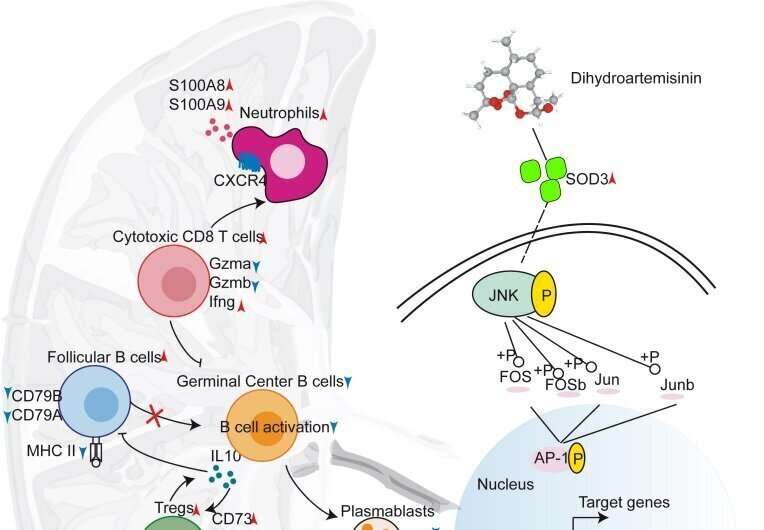Dihydroartemisinin regulates splenic immune cell heterogeneity through SOD3-JNK-AP-1 axis

Dihydroartemisinin (DHA), an active metabolite of artemisinin and the most potent anti-malaria drug, is also used to treat autoimmune diseases such as systemic lupus erythematosus (SLE) and psoriasis. Since the first report of the immunomodulatory effect of DHA in the 1990s, there has been increasing evidence that DHA beneficially regulates the host-immune systems after administration. However, the potential mechanism remains to be clarified. The team of Prof. Qijun Chen constructed the first single-cell atlas of DHA-regulated splenic immune cell subsets and revealed, using single cell RNA sequencing along with cellular and histological approaches, that DHA regulated splenic immune cell heterogeneity through SOD3-JNK-AP-1 axis.
The team found that effective regulatory T cells (Tregs) and interferon-γ (IFN-γ) + CD8+ cytotoxic T cells were accumulated in mouse spleen post-DHA treatment. The expression of immunosuppressive molecules CD73, CD274 and IL-10 were up-regulated in Tregs, whereas the expression of the key effector molecules granzyme A and granzyme B was down-regulated in IFN-γ+CD8+ cytotoxic T cells. Several studies have demonstrated that increased expression of granzyme B in activated cytotoxic CD8+ T cells and decreased immunosuppressive activity of Tregs are frequently observed in patients with SLE. "Our results may explain the effect of DHA treatment in patients with SLE," Prof. Qijun Chen says.
In the aspect of humoral immunity, the team also found that the expression of MHCII in Follicular B (FOB) cells was downregulated post-DHA treatment. Further, several key molecules associated with B cell activation, including CD79a, CD79b, and Ms4a1, were also downregulated in Fo B cells. These results suggest that DHA performs distinct effects on humoral and cellular immunity.
Through the analysis on the differentially expressed genes after DHA treatment, the team found that c-Jun N-terminal kinases (JNK) phosphorylation and activator protein-1 (AP-1) upregulation in many populations of immune cells were highly associated with DHA treatment. The researchers further confirmed that the changes in the expression of AP-1 and its upstream kinase JNK were indeed regulated by DHA using flow cytometry, Western Blot and other experimental techniques. The study further showed that increased expression of the superoxide dismutase 3 (SOD3), as a growth regulatory mediator, could drive activation of AP-1. Prof. Qijun Chen's team confirmed that DHA-induced immune cell heterogeneity and activation of JNK-AP-1 axis were abolished in the SOD3-knockout mice.
"Here, we found that the upregulation of SOD3 was closely correlated with both JNK activation and AP-1 phosphorylation as well as the downstream immune cell heterogeneity in responses to DHA treatment. Taken together, our data suggested that the immunoregulatory activity of DHA is mediated by the activation of SOD3-JNK-AP-1 axis," Prof. Qijun Chen says.
In conclusion, their study depicts the complex landscape of splenic immune cells in response to DHA treatment which lays the foundation for in-depth understanding of immune regulation mechanism of DHA.
The article was published in Science China Life Sciences.
More information: Yiwei Zhang et al, Dihydroartemisinin beneficially regulates splenic immune cell heterogeneity through the SOD3-JNK-AP-1 axis, Science China Life Sciences (2022). DOI: 10.1007/s11427-021-2061-7




















